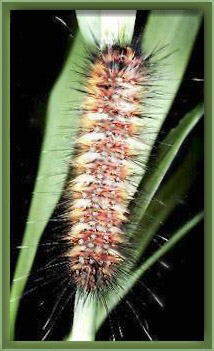
The Dreamtime myths from all parts of Australia confirm that death is an unavoidable experience of life. Death is the final crisis in a succession of initiatory rebirths that constitute the very nature of life. All Aboriginal stories relate that during the Dreamtime something might have been done to completely change the all-powerful, irreversible nature of death but the fatal step was taken by some ancestral being and set the precedent for all time. Each tribal group has a Dreamtime story that depicts the moment when death was introduced into creation.
The story from the Flinders Range in South Australia portrays two invertebrate species; the presence of such characters designates it as a story from a very early stage of the Dreaming. One creature is a spider, Adambara. The other, a furry yellow caterpillar called Artapudapuda, burrows into decomposing wood underneath the bark of eucalyptus (wida) trees. This species of caterpillar gives off a strong odour of decomposition and resembles rotten grass in colour and texture, which is what Artapudapuda means. It attacks spiders.
Adambara and Artapudapuda sat together and had a talk.
They were sorting out what should happen when people became so sick that they died. They went away to think about it for a while, then they came back together again to make a decision.
Artapudapuda said when a tribal person died his body should stay in the grave and rot, and only his spirit should rise after three days.
Adambara said no, that is not what he wanted. When a tribal person died, he said, he should be wrapped up in a web with a trap door, and the door closed and left for three days. During this time there would be a healing process, and at the end of the three days, he would come out, just as a butterfly comes out of a cocoon. This is what Adambara wanted for humans.
Artapudapuda won the argument, and the two insects went their separate ways. After a while Artapudapuda realized that his relations were dying and he wasn't seeing them again. He was getting really upset about it. He was ashamed of the decision he had made, and hid himself under the bark of a wida tree.
Adambara, on the other hand, knew he had tried his best for tribal people and was not ashamed. He stayed out in the open. This is why even today Artapudapuda is always found hiding under the bark of a wida tree, whereas Adambara is always out where he can be seen.
Top